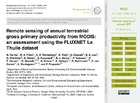Remote sensing of annual terrestrial gross primary productivity from MODIS: An assessment using the FLUXNET La Thuile dataset
Abstract
Gross primary productivity (GPP) is the largest and most variable component of theglobal terrestrial carbon cycle. Repeatable and accurate monitoring of terrestrial GPPis therefore critical for quantifying dynamics in regional-to-global carbon budgets. Re-mote sensing provides high frequency observations of terrestrial ecosystems and is widely used to monitor and model spatiotemporal variability in ecosystem propertiesand processes that affect terrestrial GPP. We used data from the Moderate ResolutionImaging Spectroradiometer (MODIS) and FLUXNET to assess how well four metricsderived from remotely sensed vegetation indices (hereafter referred to as proxies) andsix remote sensing-based models capture spatial and temporal variations in annual GPP. Specifically, we used the FLUXNET “La Thuile” data set, which includes sev-eral times more sites (144) and site years (422) than previous efforts have used. Ourresults show that remotely sensed proxies and modeled GPP are able to capture sta-tistically significant amounts of spatial variation in mean annual GPP in every biomeexcept croplands, but that the total variance explained differed substantially across15biomes (R2≈0.1−0.8). The ability of remotely sensed proxies and models to explaininterannual variability GPP was even more limited. Remotely sensed proxies explained40–60 % of interannual variance in annual GPP in moisture-limited biomes includinggrasslands and shrublands. However, none of the models or remotely sensed proxiesexplained statistically significant amounts of interannual variation in GPP in croplands, evergreen needleleaf forests, and deciduous broadleaf forests. Because important fac-tors that affect year-to-year variation in GPP are not explicitly captured or included inthe remote sensing proxies and models we examined (e.g., interactions between bioticand abiotic conditions, and lagged ecosystems responses to environmental process),our results are not surprising. Nevertheless, robust and repeatable characterization of interannual variability in carbon budgets is critically important and the carbon cycle sci-ence community is increasingly relying on remotely sensing data. As larger and morecomprehensive data sets derived from the FLUXNET community become available, additional systematic assessment and refinement of remote sensing-based methodsfor monitoring annual GPP is warranted. Show more
Permanent link
https://doi.org/10.3929/ethz-b-000077629Publication status
publishedExternal links
Journal / series
Biogeosciences DiscussionsVolume
Pages / Article No.
Publisher
CopernicusOrganisational unit
03648 - Buchmann, Nina / Buchmann, Nina
Related publications and datasets
Is previous version of: https://doi.org/10.3929/ethz-b-000088791
More
Show all metadata



